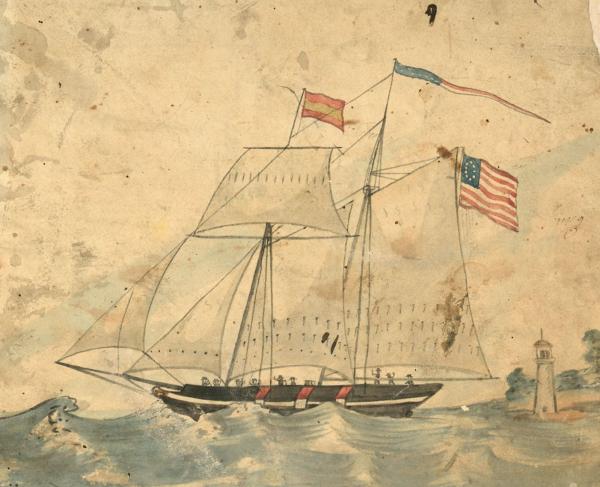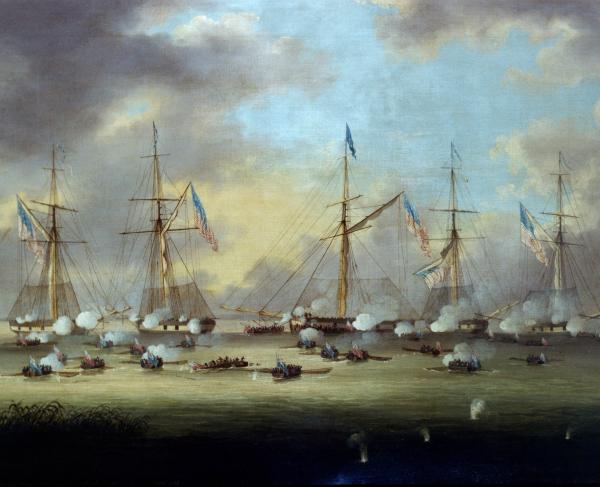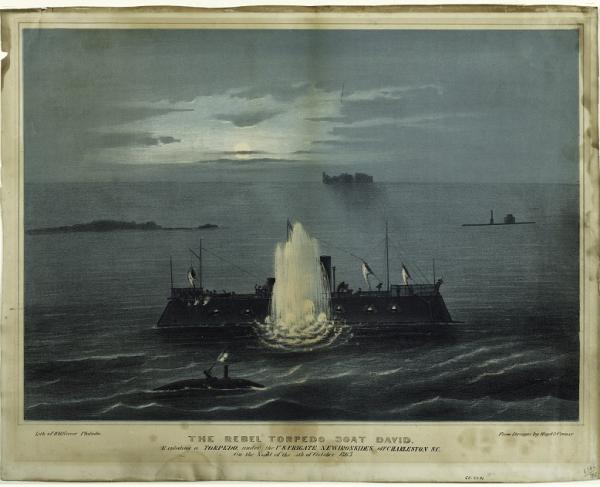10 Facts: Civil War Navies
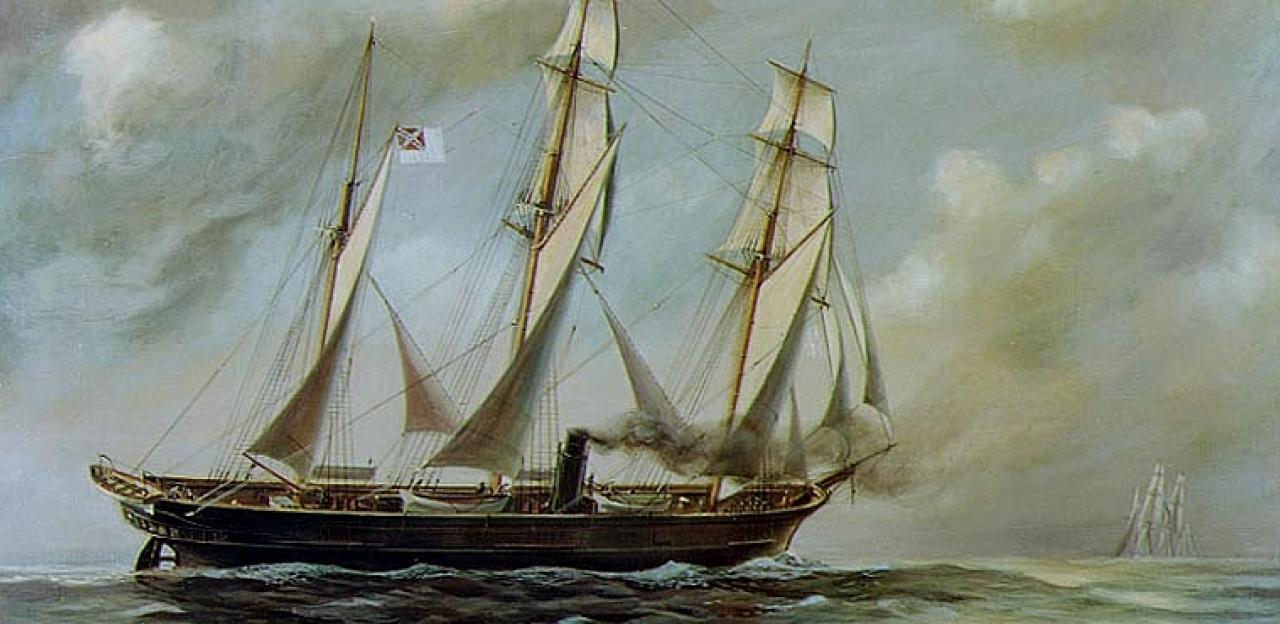
On the seas and on the rivers, the dueling navies of the Civil War irrevocably shaped the fates of the armies on land. Please use these ten facts to expand your understanding of this oft-overlooked theater of action.
Fact #1: The Union “Anaconda Plan” relied heavily on sea supremacy.
Winfield Scott, brevet lieutenant-general in command of the entire Federal army, presented Abraham Lincoln with a grand strategy for the war shortly before the Battle of Bull Run. The “Anaconda Plan” called for a stiff blockade of Southern seaports in conjunction with an amphibious advance along the line of the Mississippi River. These operations would strangle the Confederate economy, based so heavily on the international cotton trade, and split the rebellious nation apart. Although the slow and relentless squeeze of the plan was disparaged by critics who thought the conflict would be over in a matter of months, Lincoln stuck by Scott’s blueprint throughout the war.
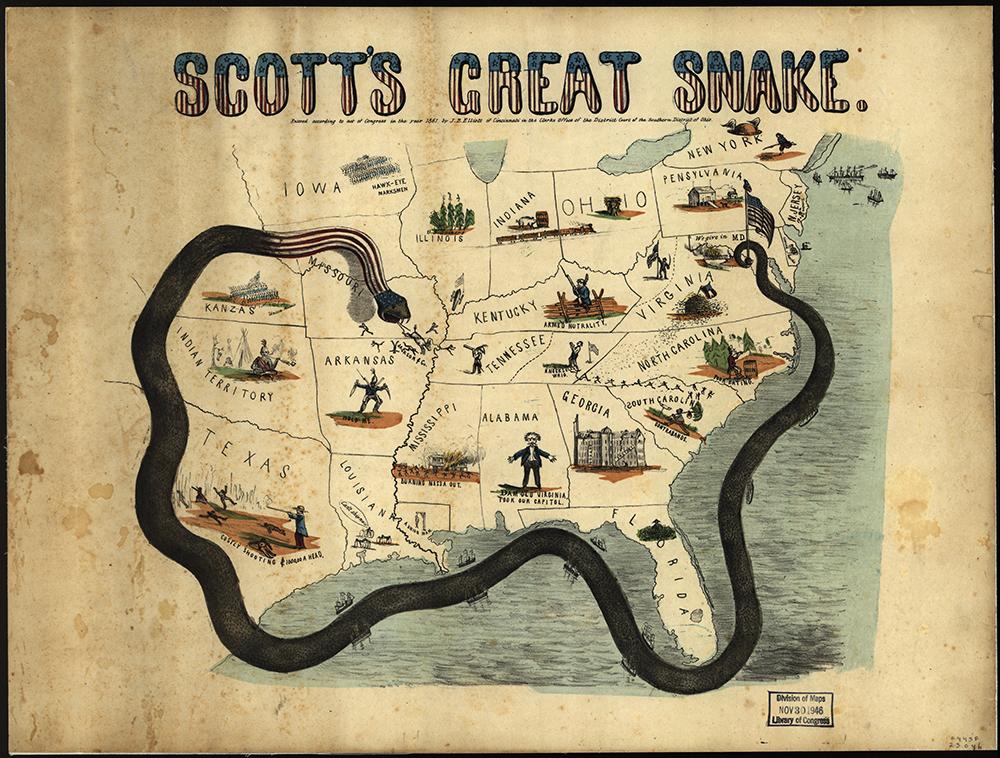
Fact #2: The Union navy grew by 600% to meet the demands of the war.
At the outset of the Civil War, the Federal navy was composed of around ninety ships, only around forty of which were close to combat-capable. The central demand of Scott’s Anaconda Plan—a blockade roughly 3000 miles in length—was far beyond what the navy was able to provide. Old ships were filled with stones and sunk in blocking positions around Southern harbors to buy time for the engineers rushing to lay down a new fleet of warships. Hundreds of civilian ships were pressed into service as well. Passenger ferries, their sturdy decks built to hold horse carriages, adapted especially well to their new role as river gunboats. The Union navy grew to comprise more than six hundred ships by 1865, the largest in the world at the time, giving the North a consistent advantage in the war on the water.
Fact #3: Naval dominance on the rivers allowed the Federals to gain an edge in the war on land.
River combat played a pivotal role in the conflict—armies could use rivers for supply routes, for fast infantry transport, and for the bombardment of enemy positions. The western theater was particularly defined by the struggle for control of the Mississippi River, which was a major factor of the final outcome of the war. Ulysses S. Grant claimed that he could not have taken the fort at Vicksburg, Mississippi without the navy. Successful river operations demanded high-tech ironclad and steam-powered fleets and led to the development of naval strategies that are still used by the American military. In terms of the number of sailors involved and the miles of river contested, the scale of the Civil War on “brown water” exceeds all other American wars, with Vietnam second.
Fact #4: The Civil War featured the first battle between ironclad ships.
The refinement of steam-powered ships changed the face of naval warfare in the late 19th century. In addition to giving ships far more freedom to maneuver against winds and currents, the extra power allowed them to carry heavier guns and heavier armor. The new technology made its historical debut when the world witnessed the first engagement between ironclad warships at Hampton Roads on March 9, 1862. The USS Monitor and CSS Virginia battled for hours before reaching a stalemate—neither carried the kind of armor-piercing shells necessary to pierce an iron hull. Nevertheless, the Battle of Hampton Roads demonstrated the viability of ironclad technology and provided a glimpse of the future of naval warfare.

Fact #5: The first successful submarine attack took place during the Civil War.
The H.L. Hunley, named for its inventor, Horace Hunley, put to sea in the summer of 1863. It was an eight-man submarine armed with a bomb mounted on the end of a 22-foot pole, known as a “spar torpedo.” Seized by the Confederacy shortly after its construction, her life was short but celebrated. She sank twice during early tests, claiming the lives of thirteen crewmen including Hunley himself. Salvaged by persistent officers, the Hunley stole out of Charleston Harbor on February 17, 1864, and crept towards the blockader USS Housatonic. In this, her only combat mission, she successfully sank the Housatonic before sinking herself for reasons still unknown. Despite this perilous beginning, engineers around the world were awakened to the potential of submarine technology. Fifty years later, 375 German “U-Boats” were wreaking havoc on the high seas.
Fact #6: Southern raiders terrorized Northern traders, reducing the strength of the Northern merchant fleet by half.
Outmanned and outgunned, the Confederates engaged in asymmetrical warfare on the high seas – intercepting Union trading ships to burn or seize their cargo. The most famous of these commerce raiders, CSS Alabama, never docked in a Confederate port and seized over seventy vessels in the Atlantic and Pacific before she was finally defeated off the coast of Cherbourg, France on June 19, 1864. The CSS Florida built a squadron of captured and converted ships that altogether took sixty prizes. Confederate sailors circumnavigated the globe and some landed in ports as far-flung as Singapore, Australia, South Africa, and Brazil. Although the Northern merchant fleet began the war with roughly 5,000 ships, many were sunk and many more were sold to foreigners by frightened owners, reducing the total to less than 2,500 by the end of the war. This feat was accomplished by less than twenty Confederate ships. The sensational nature of their exploits won international headlines and more directly affected the lives of foreign populations than the war’s land battles.
Fact #7: The Union blockade failed to stop the majority of ships that tested it, but successfully deterred the majority of the South’s pre-war international trade.
Much post-war debate has been focused on the effectiveness of the Anaconda Plan and the Union blockade. One Southern account scorns it as a “practical joke” while another claims it was a stranglehold. Considering foreign trade, it is true that most ships that tried to get through the blockade were successful—roughly 1,000 of 1,300 foreign vessels passed unharmed—but this fact is only part of the blockade’s larger impact. Although a total of 8,500 commercial vessels, including domestic Southern ships, slipped into Southern ports during the war, the volume of trade was a far cry from the 20,000 ships that docked in the years from 1856-60. The trade of cotton, the South’s largest cash crop, plummeted by 95% during the war. Although the bravery of the blockade runners provided the Confederacy with much-needed war materials and made gambling European merchants rich, the blockade still successfully suppressed a huge portion of the Southern economy.
Fact #8: Diplomatic naval crises brought the North and Great Britain to the brink of war – twice.
The specter of foreign intervention on the side of the Confederacy weighed heavily on Abraham Lincoln’s mind. Events proved his concerns to be well-placed. The first crisis came in November 1861 when a Union frigate intercepted a British mail ship, the RMS Trent, and seized two Confederate envoys that were on their way to England to lobby for intervention. In what became known as the Trent Affair, British politicians protested the affront and began a military build-up in Canada; American citizens called for war and even Lincoln indulged in some saber-rattling during his 1861 State of the Union Address. Tensions eventually eased, however, when Lincoln ordered the release of the hostages without an apology.
The second crisis came when Union spies uncovered the “Laird Ram” plot in late 1862. The spies insisted, correctly, that two ships being built in British docks for the King of Egypt--seagoing ironclads with rapid-firing revolving turrets, altogether the most powerful ships the world had yet seen—were in reality destined for the Confederacy. Lincoln, already greatly annoyed Britain’s unsubtle production of other warships for the South, would not stand for this potentially balance-shifting transaction. He threatened war, forcing the British to back down and buy the ships for themselves. The awkwardness of the issue, combined with the Civil War’s shifting tides, prompted the British to significantly decelerate their support for the Confederacy as the war continued. Nevertheless, an international arbitration court, the first in world history, ultimately awarded the United States 15.5 million dollars in reparations for the British contributions to the Confederate navy. Great Britain paid the money, but did not admit guilt.
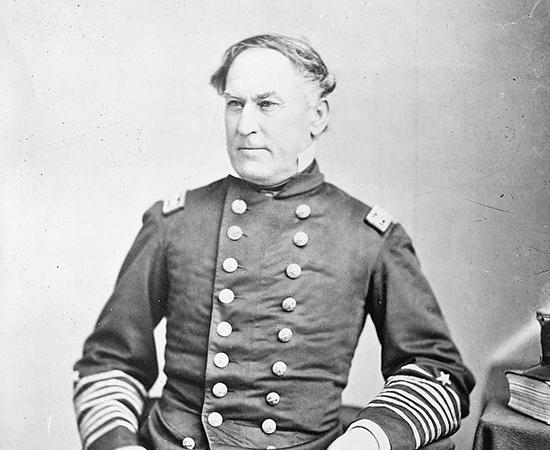
Fact #9: New Orleans, the largest city in the South, was captured primarily through naval action.
The period of economic and commercial expansion following the Louisiana Purchase earned New Orleans the moniker of “the Jewel in the Mouth of the Mississippi.” With a population that exceeded the size of the other four largest Confederate cities combined, five hundred million dollars passed through the city’s port in 1860. Its supreme importance to Southern commerce made it an early target of Flag Officer David G. Farragut, commanding the West Gulf Blockading Squadron. From the fall of 1861 until the spring of 1862 the contending navies dueled in the Gulf of Mexico, with Farragut gaining the upper hand after an early setback at the Battle of the Head of the Passes. In April of 1862, he led an attack up the Mississippi River, aiming to get his ships past Forts Jackson and St. Philip and in a position to bombard the city with impunity. After twelve days of combat, Fort Jackson was in shambles and the Union fleet had its cannons trained on New Orleans. With no organized infantry defense, New Orleans fell to an expeditionary force of 5,000 men on May 1, 1862. Its capture catapulted Farragut to fame—including a promotion to become the nation’s first admiral--and dealt a severe blow to the Confederacy.
Fact #10: The sailors on the CSS Shenandoah were the last Confederates to lower their flag.
The CSS Shenandoah, built in Britain and obtained by the Confederacy in October of 1864, operated as a commerce raider in the Atlantic, Indian, and Arctic Oceans for twelve-and-a-half months. Under the command of James Waddell, she captured seventeen prizes—mostly whaling ships—and was en route to attack San Francisco when Waddell learned of the end of the Civil War on land from the crew of the HMS Barracouta. The two ships encountered each other on August 2, 1865, more than two months after the last Confederate army had surrendered. Concerned that he and his crew would be hanged as pirates in the United States, Waddell set a course for Liverpool, England and surrendered to the British government on November 6, 1865, the last Confederates to lower their flag by a five-month margin. Waddell and his crew scattered, some making permanent new homes in foreign nations, some returning to the United States once the threat of execution subsided. The CSS Shenandoah was the only Confederate ship to circumnavigate the globe during the war.
Test Your Knowledge
